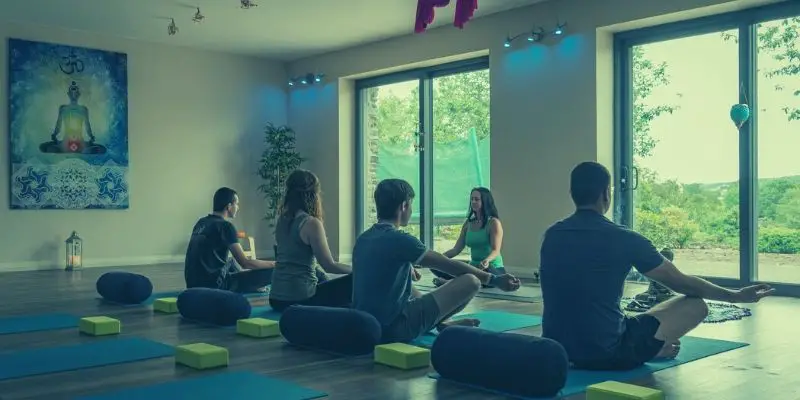Those of us who (try to) keep up a daily meditation practice know that finding that time every day can be difficult. With super-full schedules overflowing with work, children, family, friends, obligations, etc., squeezing in a significant block of meditation time each day is a challenge.
To meditate, all you really need is a relatively quiet place free from excessive distraction, and a reasonably comfortable place to set your body. One place that fits the bill is your bed! The problem is that if you try to meditate in bed, you may aim for enlightenment, but you often end up in dreamland.
This article is a look at how to meditate lying down. It focuses on meditation positions and techniques that will encourage meditation in bed without falling asleep. Meditation while lying down is a great solution to the scheduling problem. It’s easy to fit in meditation time first thing in the morning or just before sleep. We just need to find a way to stay awake during that meditation time.
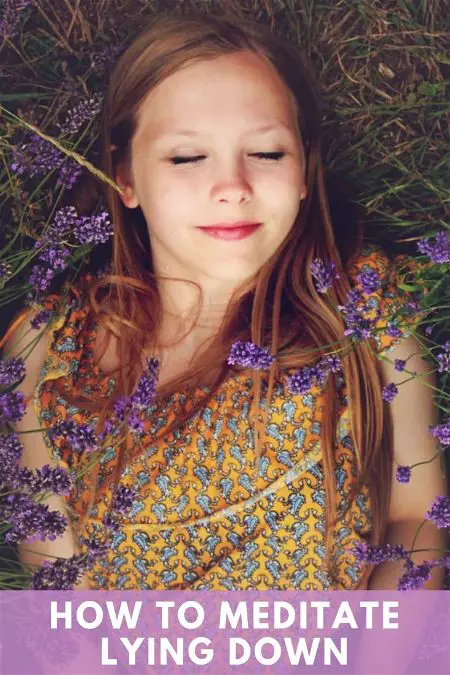
Meditating in Your Bed
While meditating is useful for inducing sleep, this is not often the goal of many meditators. We want to get in our 15-30 minutes per session of meditation without falling asleep.
To do this, we will look at a few comfortable positions for meditating in bed and a concentration technique to keep the mind engaged during the laying down meditation.
Of course, you can also sit up to meditate in your bed, and we’ll discuss that below.
But most will find it easiest to start meditating in bed by lying down, as this is an ideal position for a beginner, and it is the position you find yourself in when you wake up and when you’re ready for sleep.
How to Meditate Lying Down
The best position for laying meditation is a position familiar to anyone who has taken a yoga class: the Savasana Position (shah- VAHS – anna) Also known as Corpse Pose or Death Pose.
Combine this pose with an extra concentration technique to encourage wakefulness during the meditation.
Corpse Pose for Meditation

- Position your body so that you are laying down on your back.
- With your eyes open, begin the alignment of your body by keeping it straight. Your spine should have no curves or bends.
- Open your ankles outwards so your feet are slightly separated. Push your legs down into the bed so the muscles are squeezing.
- Then, relax the leg muscles and keep your legs still.
- Open your arms outwards with palms up. As with your legs, push them down into the bed so the muscles are squeezed. Once again
allow the muscles to relax and leave your arms in position but still. - You should now resemble a loose star position, with arms and legs slightly open and your spine straight.
- Keep all your limbs aligned with no bending of joints at the knees or elbows.
If you were able to look down on yourself, then your body shape should be symmetrical. You are now in the right physical position to begin the meditation exercise, which we discuss below.
Meditate Lying on Your Side
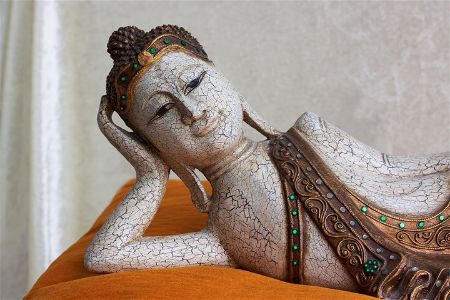
This is a great position that has been immortalized in many statues of the Buddha, showing him meditating laying on his side. Just be aware that if you have neck problems, this position is not a good choice.
- Lay down on your right side, on your mattress or a high-quality zabuton.
- Place the left arm on top of the torso
- Use the right arm to support the head in a gentle cradle position
- Place a meditation cushion or pillow under your right armpit to support the joint.
- Angle the knees so that they are not pressed directly upon each other for comfort.
You may find your right hand starting to tingle and get uncomfortable over time. This tends to help you stay awake, even while laying down. But over time you may feel the need to move it. This is fine. Just be sure to make the movement mindfully.
You can now jump down to the meditation exercise outlined below.
Burmese Position: Sitting up to Meditate in Your Bed
You don’t have to lay down to perform meditation. You can also do your relaxation exercises in a seated position on the bed. If you don’t suffer arthritis, then try sitting in the middle of the bed without back support. For beginners or those with arthritis, try the Burmese
position.
This is the easiest of positions if you can sit without back support, modeled again by the Buddha.
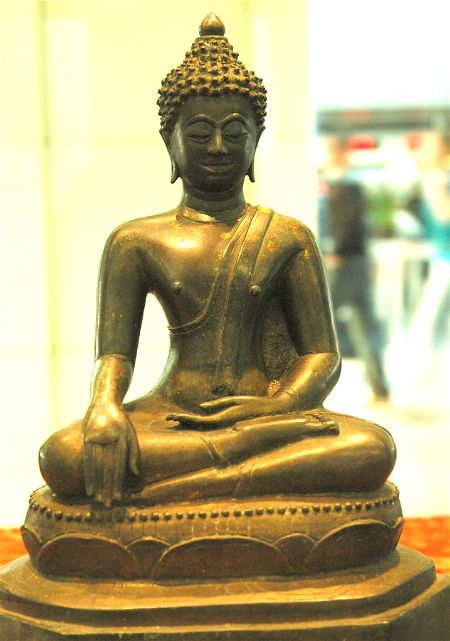
- Sit on the bed and push your legs out straight in front of you.
- Push the bottom of your spine downwards and lift your head upwards, this will help you get your spine into a straight line.
- Bend your knees so that your feet are now nearer your body.
- Move your legs down sideways, as if to cross them. All you need to do is have the outside foot touching gently on the inside ankle. Don’t cross your legs over as this will put pressure on the one that is underneath. It’s only a case of leaning the outside ankle on the inside leg or foot.
If you can’t cross your legs, no worries.
Crossing legs with joint and muscles problems can sometimes cause pain. Instead, lean your back against the headboard or wall at the top of your bed. Put your legs out straight in front of you and slightly apart. It’s important to have a straight back. Position your body in an L-shape, otherwise, you’ll become uncomfortable.
Many find using a pillow or meditation bolster for support can be helpful. But if your position gets too comfortable, you may find yourself in dreamland.
Now let’s dig into the concentration technique that can help keep you awake.
Mindful Breathing and Concentration Technique
Learn how to relax your body in preparation for the mind and body exercises to flow.
- Close your mouth and inhale deeply through your nose for around 7 seconds.
- As you do so, allow your stomach to expand outwards, and your chest to raise a little.
- Hold the breath for around 5 seconds.
- Open your mouth and exhale the air, while you do so imagine that you are expelling all the day’s stress out your body.
- Repeat the process of inhalation and exhalation.
- Focus on the sensation of the air flowing at the nostrils. This sensation is pretty mild and is often barely perceptible, but it is there. It requires a lot of concentration to keep the focus of attention there. This is why it’s a good choice for lying down meditation.
- Repeat, until you feel that your body is relaxed and loose. You should be laying down and unmoving, other than your breathing. No clenched muscles anywhere, as they should all be relaxed.
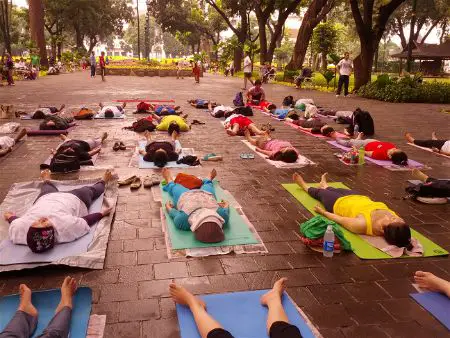
Attention vs. Awareness
Remember the distinction between attention and awareness. Awareness is what you perceive in your senses. Attention is the focus of your mind. These two aspects of consciousness may be focused on the same thing, but often they are not.
For this meditation, you want to keep your attention on your breath at the nostrils, but you will move your awareness around your body, and the room. When your attention wanders from the breath at the nostrils, acknowledge the wandering, and gently move your attention back to your breath.
Clear Your Mind
You have now reached a point where you can begin to meditate. This will start to help clear your mind and soothe the physical body.
You should be breathing normally through your nose, calm and regular. Choose to open or close your eyes, as you see fit. Continue to focus your attention on the nostrils.
- Open your awareness to your body, and to the environment around you. Allow any sounds you hear or sensations you feel to wash over you. Accept them into your awareness, but don’t make them the focus of your intention.
- Become aware of your body and begin to scan it. Roll up your tongue and feel the soft palate on the roof of your mouth. Rub it carefully with the tip of your tongue for a few seconds. Return your tongue so it sits on the roof of your mouth with the tip behind the top front teeth.
- Imagine that you have left your physical body and are looking down at yourself. Scan your whole body starting at the face. Look
at your nose. Can feel your nostrils moving as you breath? Can you feel the air entering your nose and going down to your lungs?
Think about that point between exhaling and inhaling. What happens to your body at that point, if anything? - When you feel ready, move on to another part of your body. You could stay on your face and imagine you are looking at the point between your brows. Or, go to your ears and focus on what you can hear. Is your mouth open or shut? Work your way all-around your body asking yourself questions. Are your hands cold or warm? Can you feel the air on your feet? Do you feel heavy or light?
If you want to open your eyes, you can allow your awareness to flow throughout the room. Identify the various objects in the room, the play of light on those objects, the colors, and textures. If you want to keep your eyes closed, you might accept into your awareness the temperature of the room, the flow of air in the room, the sounds of the birds chirping outside, and the sound of your dog (or spouse) snoring next to you.
Again, the key is to allow these stimuli into your awareness while not making them the focus of your attention, which will stay on the breath. This method will encourage you to stay awake and engaged even while meditating laying down.
This meditational session can take from 10-30 minutes. The idea is not to sleep, but to switch your mind from the troubles of your day.
Ending Your Meditational Session
Once you end your relaxation exercise, here’s how to finish the session correctly:
- Stay in the same position for another 4-5 minutes.
- Do the deep breathing exercises, in through your nose and out of your mouth.
- Once you feel ready, inhale a deep breath and as you exhale, roll gently to your right side.
- Stay in that position for 2-3 normal breaths and then take in another deep breath through your nose.
- Again, as you exhale, use your hands to help you to get to a seated position on the bed.
- Hopefully, you will now be refreshed with a clear mind and relaxed body.
Final Tips
However you decide to sit, you must be naturally comfortable. Here are a few more tips to help with comfort while meditating in bed:
- Meditating in the morning is a good way to start your day, and it also means you can do the exercise in your nightclothes.
- If you’re restricted with a time limit, set an alarm on your phone or watch to let you know when it’s time to end your session. That way you won’t be worrying about time while meditating.
- To benefit from meditation, it’s best to do a short session every day. You need to practice daily to become experienced.
- Begin with 10-minute sessions for the first week. Add another 5 minutes with each passing week. Aim for a 30-minute session on a
daily basis.
Meditation is not easy and takes lots of practice. To master the best techniques can take years. When you first start, you may find it difficult to concentrate your mind on the session. That’s why it’s good to have a routine. By building up a regular pattern of meditational exercises, you’ll soon find it easier to concentrate during your sessions.
Learning to meditate while walking, running, sitting, laying down, etc. will make getting those regular daily sessions a much more flexible and attainable task.



